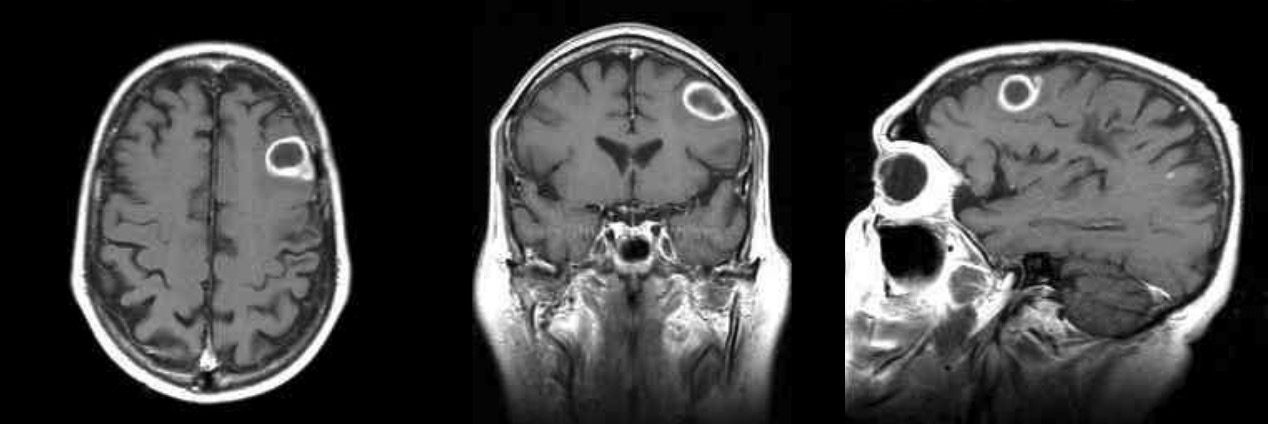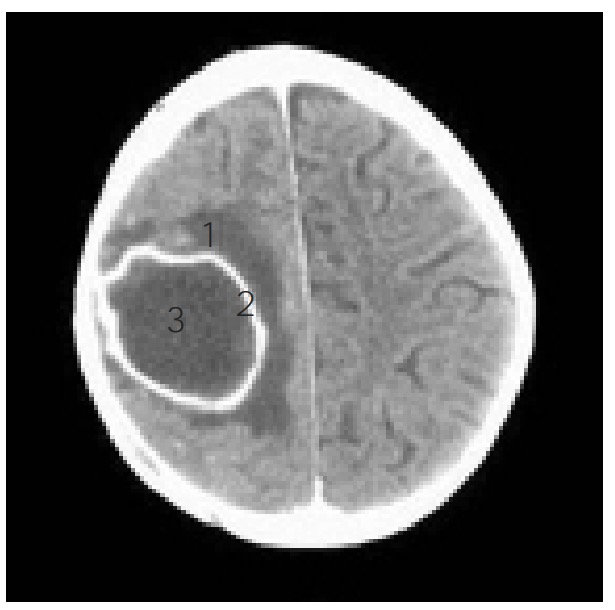Brain abscess is a life-threatening condition that involves the collection of pus in the brain parenchyma caused by infection from bacteria, fungi, parasites, or protozoa. The most common presentation is headache, fever with chills, seizures, and neurological deficits. Diagnosis is mainly based on imaging, as it is difficult to arrive at a definitive diagnosis based on clinical presentation alone. Management includes administration of empiric antibiotic therapy and surgical intervention. Immediate management is necessary; otherwise, severe neurologic complications ensue.
Last updated: Mar 4, 2024
Brain Brain The part of central nervous system that is contained within the skull (cranium). Arising from the neural tube, the embryonic brain is comprised of three major parts including prosencephalon (the forebrain); mesencephalon (the midbrain); and rhombencephalon (the hindbrain). The developed brain consists of cerebrum; cerebellum; and other structures in the brain stem. Nervous System: Anatomy, Structure, and Classification abscess Abscess Accumulation of purulent material in tissues, organs, or circumscribed spaces, usually associated with signs of infection. Chronic Granulomatous Disease is an uncommon but life-threatening infectious collection of pus in the brain Brain The part of central nervous system that is contained within the skull (cranium). Arising from the neural tube, the embryonic brain is comprised of three major parts including prosencephalon (the forebrain); mesencephalon (the midbrain); and rhombencephalon (the hindbrain). The developed brain consists of cerebrum; cerebellum; and other structures in the brain stem. Nervous System: Anatomy, Structure, and Classification parenchyma.
There are 2 routes of the spread of infection to the brain Brain The part of central nervous system that is contained within the skull (cranium). Arising from the neural tube, the embryonic brain is comprised of three major parts including prosencephalon (the forebrain); mesencephalon (the midbrain); and rhombencephalon (the hindbrain). The developed brain consists of cerebrum; cerebellum; and other structures in the brain stem. Nervous System: Anatomy, Structure, and Classification:
Organisms causing brain Brain The part of central nervous system that is contained within the skull (cranium). Arising from the neural tube, the embryonic brain is comprised of three major parts including prosencephalon (the forebrain); mesencephalon (the midbrain); and rhombencephalon (the hindbrain). The developed brain consists of cerebrum; cerebellum; and other structures in the brain stem. Nervous System: Anatomy, Structure, and Classification abscess Abscess Accumulation of purulent material in tissues, organs, or circumscribed spaces, usually associated with signs of infection. Chronic Granulomatous Disease:[1,3,5]
Risk factors:[1,3–5]
Early cerebritis Early Cerebritis Brain Abscess (days 1–3):
Late cerebritis Late Cerebritis Brain Abscess (days 4–9):
Early capsule formation Early Capsule Formation Brain Abscess (days 10–13):
Late capsule formation Late Capsule Formation Brain Abscess (day 14 +):
Capsule Capsule An envelope of loose gel surrounding a bacterial cell which is associated with the virulence of pathogenic bacteria. Some capsules have a well-defined border, whereas others form a slime layer that trails off into the medium. Most capsules consist of relatively simple polysaccharides but there are some bacteria whose capsules are made of polypeptides. Bacteroides becomes thick and is amenable to excision.

T1-weighted gadolinium-enhances images: MRI of a brain abscess showing the classic “ring-enhanced” lesion
Image by Roy Strowd, M.D.
The parts of a brain abscess as observed on a CT scan:
1: edema
2: ring
3: abscess core
Other laboratory tests[11]
Management is based on a combination of medical and surgical treatment. A neurosurgeon should be contacted after the initial diagnosis of a brain Brain The part of central nervous system that is contained within the skull (cranium). Arising from the neural tube, the embryonic brain is comprised of three major parts including prosencephalon (the forebrain); mesencephalon (the midbrain); and rhombencephalon (the hindbrain). The developed brain consists of cerebrum; cerebellum; and other structures in the brain stem. Nervous System: Anatomy, Structure, and Classification abscess Abscess Accumulation of purulent material in tissues, organs, or circumscribed spaces, usually associated with signs of infection. Chronic Granulomatous Disease. Antibiotic therapy may be delayed to obtain cultures unless the patient is critical or septic.[6,7]
Antibiotics:
| Antimicrobial | Dosing |
|---|---|
| Cefotaxime Cefotaxime Semisynthetic broad-spectrum cephalosporin. Cephalosporins | 2 g IV every 4‒6 hours |
| Ceftriaxone Ceftriaxone A broad-spectrum cephalosporin antibiotic and cefotaxime derivative with a very long half-life and high penetrability to meninges, eyes and inner ears. Cephalosporins | 2 g IV every 12 hours |
| Cefepime Cefepime A fourth-generation cephalosporin antibacterial agent that is used in the treatment of infections, including those of the abdomen, urinary tract, respiratory tract, and skin. It is effective against pseudomonas aeruginosa and may also be used in the empiric treatment of febrile neutropenia. Cephalosporins | 2 g IV every 8 hours |
| Ethambutol Ethambutol An antitubercular agent that inhibits the transfer of mycolic acids into the cell wall of the tubercle Bacillus. It may also inhibit the synthesis of spermidine in mycobacteria. The action is usually bactericidal, and the drug can penetrate human cell membranes to exert its lethal effect. Antimycobacterial Drugs | 15 mg/kg orally every 24 hours |
| Isoniazid Isoniazid Antibacterial agent used primarily as a tuberculostatic. It remains the treatment of choice for tuberculosis. Antimycobacterial Drugs | 300 mg orally every 24 hours |
| Metronidazole Metronidazole A nitroimidazole used to treat amebiasis; vaginitis; trichomonas infections; giardiasis; anaerobic bacteria; and treponemal infections. Pyogenic Liver Abscess | 500 mg IV every 6‒8 hours |
| Nafcillin Nafcillin A semi-synthetic antibiotic related to penicillin. Staphylococcal Scalded Skin Syndrome (SSSS) | 2 g IV every 4 hours |
| Oxacillin | 2 g IV every 4 hours |
| Pyrimethamine Pyrimethamine One of the folic acid antagonists that is used as an antimalarial or with a sulfonamide to treat toxoplasmosis. Antimalarial Drugs | 50‒75 mg orally every 24 hours |
| Pyrazinamide Pyrazinamide A pyrazine that is used therapeutically as an antitubercular agent. Antimycobacterial Drugs | 15‒30 mg/kg orally every 24 hours |
| Rifampin Rifampin A semisynthetic antibiotic produced from streptomyces mediterranei. It has a broad antibacterial spectrum, including activity against several forms of Mycobacterium. In susceptible organisms it inhibits dna-dependent RNA polymerase activity by forming a stable complex with the enzyme. It thus suppresses the initiation of RNA synthesis. Rifampin is bactericidal, and acts on both intracellular and extracellular organisms. Epiglottitis | 600 mg orally every 24 hours |
| Sulfadiazine Sulfadiazine One of the short-acting sulfonamides used in combination with pyrimethamine to treat toxoplasmosis in patients with acquired immunodeficiency syndrome and in newborns with congenital infections. Sulfonamides and Trimethoprim | 1 g (< 60 kg), 1.5 g (≥ 60 kg) orally every 6 hours |
| Trimethoprim Trimethoprim The sulfonamides are a class of antimicrobial drugs inhibiting folic acid synthesize in pathogens. The prototypical drug in the class is sulfamethoxazole. Although not technically sulfonamides, trimethoprim, dapsone, and pyrimethamine are also important antimicrobial agents inhibiting folic acid synthesis. The agents are often combined with sulfonamides, resulting in a synergistic effect. Sulfonamides and Trimethoprim– sulfamethoxazole Sulfamethoxazole A bacteriostatic antibacterial agent that interferes with folic acid synthesis in susceptible bacteria. Its broad spectrum of activity has been limited by the development of resistance. Sulfonamides and Trimethoprim | 10‒20 mg/kg/day ( trimethoprim Trimethoprim The sulfonamides are a class of antimicrobial drugs inhibiting folic acid synthesize in pathogens. The prototypical drug in the class is sulfamethoxazole. Although not technically sulfonamides, trimethoprim, dapsone, and pyrimethamine are also important antimicrobial agents inhibiting folic acid synthesis. The agents are often combined with sulfonamides, resulting in a synergistic effect. Sulfonamides and Trimethoprim component) IV in 2‒4 divided doses/day |
| Vancomycin Vancomycin Antibacterial obtained from streptomyces orientalis. It is a glycopeptide related to ristocetin that inhibits bacterial cell wall assembly and is toxic to kidneys and the inner ear. Glycopeptides | |
| Voriconazole Voriconazole A triazole antifungal agent that specifically inhibits sterol 14-alpha-demethylase and cytochrome p-450 cyp3a. Azoles |
Glucocorticoids Glucocorticoids Glucocorticoids are a class within the corticosteroid family. Glucocorticoids are chemically and functionally similar to endogenous cortisol. There are a wide array of indications, which primarily benefit from the antiinflammatory and immunosuppressive effects of this class of drugs. Glucocorticoids:
Seizure prophylaxis Prophylaxis Cephalosporins:[11]
General principles:[11]
Needle aspiration Needle aspiration Using fine needles (finer than 22-gauge) to remove tissue or fluid specimens from the living body for examination in the pathology laboratory and for disease diagnosis. Peritonsillar Abscess (preferred):[6–10]
Surgical excision:[6–11]
Surgical intervention could be avoided if:[6–10]